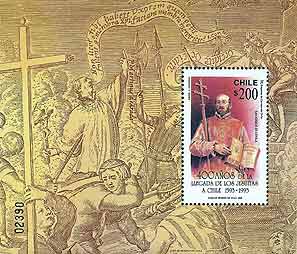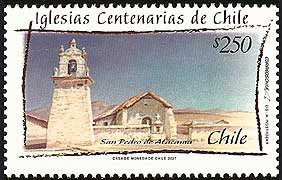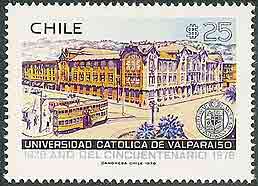
CHILE, 1993, the 4th centenary of the arrival of Jesuits, Scott 1040a
JESUIT
INSTITUTIONS |
Four Hundred Years

CHILE, 1993, the 4th centenary of the arrival of Jesuits,
Scott 1040a
San Pedro de Atacama Church and Museum

CHILE, 2008, anniversaries of Chilean churches, Scott 1474b
The Church of San Pedro de Atacama is the site of the labors of Jesuit priest Fr. Gustavo Le Paige who was was born on November 24, 1903 in Tilleur, Belgium. He entered the Jesuits in Arlon in 1922, studied at the University of Louvain, and worked as a missionary in Belgium Congo from 1936 to 1952. He came to Chile in 1953 and was assigned in 1955 to the San Pedro de Atacama Church which dates back to 1774. He worked there until his death on May 19, 1980, doing pastoral, social and archaeological work. In 1957 he set up a small museum in the parish house with relics of the Atacamenian culture. He established a museum able to host 380,000 items gathered from more than 300 archaeological sites, and was able to do so with the help of the Catholic University of the North which now runs the museum. The museum is across the street and about 100 meters to the northeast of the Church, and both museum and street are now named in Le Paige's honor. During his 20 years in Chile, Father Le Paige wrote four books and about twenty articles on the Atacamenians.
Scott 1053
ChonchiScott 1054
VilupulliScott 1055
Llau-LlaoScott 1056
DalcahueScott 1057
Tenaún
Scott 1036
AchaoScott 1129
AchaoScott 1038
AchaoScott 1039
Castro
Scott 1037
CastroScott 1130
CastroScott 1058
QuinchaoScott 1093
Quinchao
Scott 1059
QuehuoScott 1095
QuehuoScott 1060
NercónScott 1097
Nercón
Scott 1375
QuinchaoScott 1376
TenaúnScott 1399
AchaoScott 1400
DalcahueCHILE, 1993-1996, Scott 1036-39, 1053-60, 1093-98, 1129-30
CHILE, 2001-2002, Scott 1375-76, 1399-1400Chiloé in southern Chile is the second largest island in South America. The Spanish arrived there in 1553. Franciscans and other missionaries came in the 16th century, but the distinctive hallmark of the island churches was struck with the arrival of the Jesuits in 1608. The Jesuits established an itinerant mission, in which groups of Jesuit missionaries would make annual trips around the archipelago, staying for a few days in areas where they built these wooden chapels, and around which hamlets grew up. A layman was appointed to work in each area during the rest of the year. The system was continued by the Franciscans after the Jesuits were expelled in 1767.

CHILE, 1978 and 1998, the 50th and 70th anniversary of the university, Scott 522, 1263
The University of Valparaiso was under the direction of the Jesuits from 1951 to 1963, during which time the enrollment rose from 300 to 6000 students.
Catholic University of the North
CHILE, 2006, the 50th anniversary of the Catholic University of the North, Scott 1463
While the Catholic University of the North is not a Jesuit university, it was founded with so much collaboration by the Jesuits of Chile that we include this anniversary issue here.
CHILE, 2013, the 200th anniversary of the National Library of Chile, Scott 1598
When the Jesuits were expelled from Chile in 1767, they possessed a library of 20,000 books. When the National Library was founded on August 13, 1813 during the early years of Chile's independence, its basic collection was 8,000 volumes that had belonged to the colonial library of the Jesuits. These had been preserved in the University of San Felipe until their transferal to the National Library. While the library itself is not a Jesuit institution, it grew from the collection provided by them.